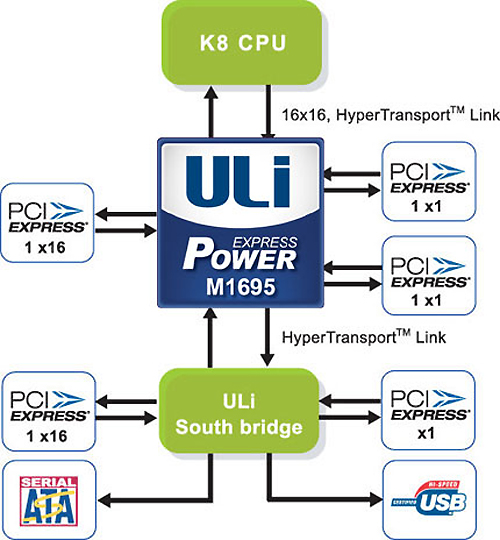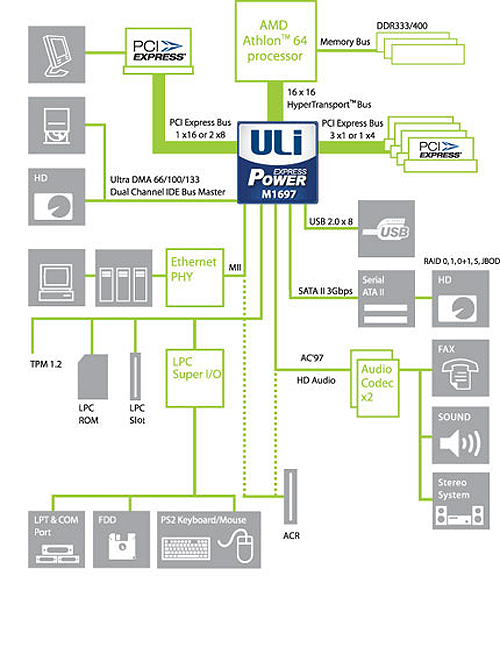ASRock 939SLI32-eSATA2: ULi Dual x16 SLI
by Gary Key on March 2, 2006 12:15 PM EST- Posted in
- Motherboards
"The more alternatives, the more difficult the choice."
This quote by Abbe' D'Allanival conveys our feelings about the ASRock 939SLI32-eSATA2 product. ASRock began operations in 2002 as the value brand group for Asus. ASRock has a history of providing very unique and, at times, unusual products based upon alternative chipsets at inexpensive price points. Although ASRock offers a complete line of products based upon mainstream chipsets from Intel and NVIDIA, it is their products based upon ULi, SIS, and VIA chipsets that are usually far more interesting. More information about the entire line of ASRock products can be found here.The ASRock 939SLI32-eSATA2 motherboard is based on the ULi M1697 and M1695 chipsets. ASRock has done a masterful job in utilizing these recently released chipsets to create a board that might make you think twice about spending any additional money for an NVIDIA nForce4 dual X16 SLI solution. In fact, this board fully supports NVIDIA SLI technology and it works seamlessly with the included ULi PowerExpress Engine Enabling driver although the board is not SLI certified by NVIDIA. Of course, now that NVIDIA has completed their acquisition of ULi, we have to wonder how many manufacturers will be able to provide a similar solution utilizing these chipsets or how long this driver will be available.

During our testing and general usage of the ASRock 939SLI32-eSATA2, we found the board's stability to be exceptional and it delivered competitive results in the latest synthetic and game benchmarks. However, our initial impressions were not as positive at the beginning of the test phase as the board would sporadically produce random results in the synthetic benchmarks while generating lockups in the memory benchmarks. Our issue was with the pre-release test BIOS and was not visible in the production release BIOS on the shipping boards. While the performance of the board was slightly lower in most benchmarks, the stability was superb with the release BIOS.

ASRock utilizes the ULi M1695 HyperTransport PCI Express Tunnel chip for the North Bridge. The ULi M1695 is designed to interconnect seamlessly with other HyperTransport based Host or Bridge chips and, in this case, is interconnected to the ULi M1697 acting as the South Bridge. The M1695 fully supports one PCI Express x16 lane or two x8 lanes for graphics cards and two PCI Express x1 or one PCI Express x4 expansion slot. The M1695 offers transfers of up to 16-bit HTT downstream and 16-bit HTT upstream links at 2.0 GT/s, ensuring an excellent communication path between the processor and connecting bridges.

The ASRock 939SLI32-eSATA2 offers the full complement of options available including two PCI Express x16 connections (fully supports NVIDIA SLI with PowerExpress driver); one PCI Express x4 connection, three 32-bit PCI 2.2 connections, and a unique CPU upgrade port that fully supports the AM2 940-pin CPU with an AM2CPU daughter board. The board also offers HD audio via the Realtek ALC660 HD 5.1 codec, PCI Express Gigabit Ethernet via the Realtek RT8111B PHY, eight USB 2.0 ports (utilizing two USB 2.0 headers), four SATA 3Gb/s connectors, two eSATA 3Gb/s connectors (shared with two SATA 3Gb/s ports), two ATA133 Ultra-DMA IDE connectors, and IEEE 1394 support via the TI TSB43AB22 1394A capable chipset.
Let's find out if this alternative offering leads to a difficult choice.










46 Comments
View All Comments
Zoomer - Tuesday, March 7, 2006 - link
This board would cannabilize sales of the premium SLI32 and xfire board that Asus sells for $150 IF it included voltage settings up to 2v vCore, 3.2v vMem, etc.They would be stupid to do it. These people will pay the $150 anyway if they don't have an easy (cheap) alternative. For the rest of us, we can get busy with a 2B pencil, solders or conductive ink. ;) And forgo the warranty on it, so if it goes boom in a year's time, you're on your own.
Nice strategy. Would AT leak the beta bios for comparison's sake? (We'll smuggle it to xs or ocwb....:D)
poohbear - Thursday, March 2, 2006 - link
and for the record the dualsata2 is a very stable mobo @ stock settings, i have to give credit where it's due, but for overclocking this company's products shouldnt even be considered.sandorski - Thursday, March 2, 2006 - link
It kinda sucks Nvidia bought out ULI, they were very innovative and really filled niche markets very well. Then again, perhaps Nvidia will let them continue doing interesting things there?Cygni - Thursday, March 2, 2006 - link
Hard to argue with that... looks like ASRock/ULi has another mega seller on their hand with this baby. But I cant help but wish it had an AGP slot thrown in between the two PCI-Ex lanes, to allow an upgrade path. Thats probably the primary reason the ULi 1695 boards have been selling so well.The IDE and SATA performance numbers are really striking in contrast to Nvidia's. I hope we see the inclusion of ULi's storage controller in future Nvidia chipsets.
All for $85... awesome.
Furen - Thursday, March 2, 2006 - link
If it had an AGP slot then it would have to use ULi's AGP tunnel + the 1697 instead of the 1695 + 1697, which would mean that it'd only have 16 PCI-e lanes for graphics. I suppose most of us wouldn't mind going for two 8x slots while in SLI but then most of us wouldn't really want SLI to begin with.JackPack - Thursday, March 2, 2006 - link
Quality doesn't seem to be bad either. Panasonic and UCC caps in there.